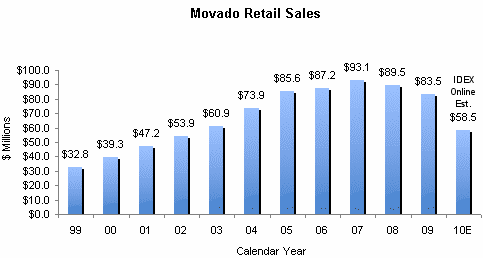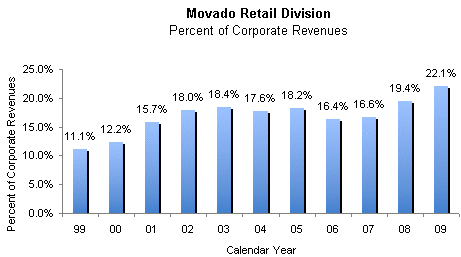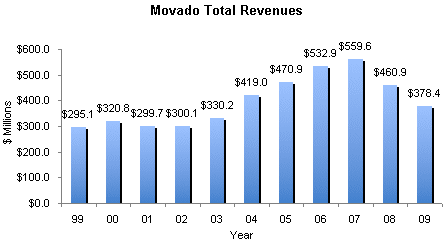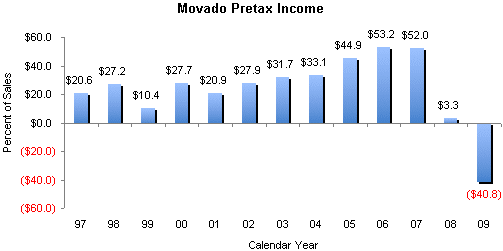IDEX Online Research: Movado Store Closings Are Latest Challenge
June 16, 10
Over the years, Movado has had more than its share of challenges. Some of its acquisitions in the past decade have been a drag on results for far too long. Its licensed brand deals seem slow to come to fruition. It is fighting for market share in a market where consumers would rather check the time on their mobile phone than spend big bucks on a timepiece.
And, last, but not least, Movado’s retail boutique division has been an albatross for the company.
While the 31 Movado Outlet stores have been contributing to operating income, its 27 retail Movado Boutiques have never been profitable. Worse, near-term prospects for profitability in the boutique division seem dismal.
As a result, Movado’s management announced that it is closing its Movado boutiques – 26 of the 27 units, all located in the U.S. These units will be shuttered by the end of June. The only remaining boutique will be a flagship store in Rockefeller Plaza in New York City.
Those 26 units generated about $30 million in annual sales – just over $1.1 million in annual per-store sales, roughly in line with the industry average for specialty jewelers – but lost a whopping $10 million annually.
Management defended its boutique store strategy, asserting that the stores increased visibility of Movado’s brands and provided a testing ground for new merchandise and other programs. However, management also acknowledged that the boutique division would remain unprofitable in 2010, if they continued to operate. Further, their long term profitability prospects were unpredictable.
The closing of the boutiques will cost about $25 million in one-time charges (of which about $21 million or so will be cash charges). About 225 employees will be affected by the store closures. Non-watch inventory – mostly fine jewelry – will be liquidated, but Movado management promised that it would not blow out Movado branded watches at liquidation prices. This will help the company maintain good relations with its wholesale and retail customers.
Movado Retail Challenges
In our opinion, the Movado boutiques suffered from several maladies, including the following:
· The stores’ market niche was never clear – The Movado boutiques originally carried mostly Movado-branded watches, but fine jewelry was added a few years ago in an effort to punch up their image as a specialty jeweler, increase traffic and boost margins.
· Prices were “full retail” – The boutiques generally held the line on retail prices, while competing with Movado’s wholesale customers who often offer discounts on Movado’s watch lines.
· The stores weren’t compelling – When we went mystery shopping, the Movado stores were usually a “big yawn” in terms of merchandise and marketing excitement.
· The owner is a manufacturer – It is very rare for a manufacturer in any industry to successfully operate a retail division: the culture is simply far too different.
· Real estate costs were high – Like most jewelers, landlords demanded top-end rents from Movado. The margin structure in watches does not support high occupancy costs.
· Retail management turned over – The company was never particularly forthcoming about its management talent in the retail division. However, our sense, confirmed by insiders, is that there never was clear direction from top management in the retail division, and management seemed to turn over at a rate greater than average.
· Infrastructure costs were too high – Movado was never able to align its retail overhead costs with the revenue levels produced by its stores.
· First quarter 2010 sales trends remain weak – While the overall jewelry industry has been posting sales gains in the first few months of 2010, Movado’s retail division had a weak first quarter. Total retail sales declined by 4 percent, with Movado boutiques posting a 5 percent decline and the Movado Outlet stores posting a 3 percent drop in sales.
We are a bit surprised at the sales weakness in the outlet stores, since they have typically outperformed the boutique units by a wide margin in prior quarters. This may be due to management’s lack of focus on day-to-day operations; rather, they have been focusing on strategic issues. Movado management noted that fine jewelry sales in the Movado boutiques showed some strength in the first quarter, but not enough to reconsider the decision to close these units.
Movado’s Store Closings Take Capacity Out of the Jewelry Industry
While only 26 units are being closed – one-tenth of one percent of the nation’s 24,000 specialty jewelry stores – it is just one more sign of potential accelerating consolidation in the industry. Larger chains such as Friedman’s, Whitehall and Finlay have folded; now, smaller chains are beginning to exit.
With $30 million in sales up for grabs – again, roughly one-tenth of one percent of specialty jewelers’ sales of $28 billion – no single jeweler will pick up any notable market share. However, this is just one more example of industry consolidation that will leave the survivors with additional market share from the failures, along with inherent jewelry industry sales growth. In short, Movado’s store closings will be good for the remaining specialty jewelers in the industry.
Retail Revenues Peaked in 2007
At their peak in 2007, Movado’s retail division generated just over $93 million in sales. The company never disclosed much about the retail division, other than some top line revenue and operating income data. The graph below illustrates annual revenues for the Movado retail division since it became a reportable entity for the calendar year 1999 (fiscal year ended January 2000).
In addition, we have included our revenue forecast for calendar 2010 (FYE 1/11), with a range of $57-60 million from continuing operations, reflecting the closure of the boutique stores for the full year (their results will be reported as “discontinued operations” for the full year).

Source: Company reports
For the most recent fiscal year, the retail division produced just over $83 million in revenues. This means that the remaining 31 Movado outlet stores and one flagship boutique generated about $53 million in sales, or about $1.7 million in per-store sales. This level of Movado outlet per-store sales is about 50 percent greater than the average for the typical specialty retailer in the U.S. American shoppers love a bargain, and the Movado outlet stores create the perception of offering a value.
While the Movado boutiques lost about $10 million annually, we estimate that the Movado outlets contributed about $6 million in operating profits annually, or just over 10 percent of sales. For the most recent fiscal year, the combined operating loss for the retail division (Movado boutiques + Movado outlets) was $3.6 million. This loss includes some impairment charges of about $5 million related to the boutique division. Even if these impairment charges are removed, the boutique stores did not contribute to operating profits in 2009.
How important is the total retail division – boutiques and outlets – to Movado? While it has been a drag on profits, it has been a meaningful portion of total corporate revenues, as the graph below illustrates.
 Source: Company reports |
Wholesale Business Recovering
If last year was the “year of de-stocking’ for retailers, then this year is the ‘year for re-stocking” for those merchants. In 2009, Movado’s wholesale sales to U.S. merchants were down nearly 30 percent. In this year’s first fiscal quarter ended April, Movado’s U.S. wholesale sales rebounded by a dramatic 63 percent. All categories of Movado’s watch brands – luxury, accessible luxury and licensed goods – posted higher sales.
Outlook: “Rebuild and Return to Core Values”
Movado chairman Efraim Grinberg has said that 2010 will be the year to rebuild Movado and return to its core values. We interpret this to mean that the company will focus on developing its wholesale business in a rational way. Its outlet stores will continue to sell discontinued watch models and factory seconds of all Movado branded products, but will not offer goods that are directly competitive to the specialty jewelers that it supplies.
Movado’s corporate revenues, including wholesale and retail sales, were particularly hard-hit early in the recession, as the graph below illustrates. Retail jewelers simply stopped ordering, and they let their stock of merchandise run down, rather than replacing goods as they were purchased by shoppers. However, we sense that the challenge to rebuild Movado and return it to core values is greater than simply waiting for an economic recovery which will provide an automatic lift to sales are retailers rush to re-stock goods.
 Source: Company reports |
In addition to rebuilding revenues, Movado management needs to return the company to profitability. Grinberg noted that 2009 was the first time the company had posted an annual loss in its history. The following graph illustrates pretax income levels for Movado back to 1997.

Source: Company reports
Management’s Outlook
Movado management provided an outlook for the balance of 2010 as follows:
· There will be unusual costs related to the store closings. Estimates peg the number at about $25 million, of which $3-4 million or so will be non-cash. Movado can finance this internally.
· Management anticipates that its gross margin will be about 56 percent for the year. This is well below its historic levels of 60 percent or so, but is a dramatic recovery from last year’s depressed 48.8 percent, which included significant liquidation sales at low margins.
· The operating cost ratio will likely be up due to higher marketing costs. We’re not sure what this means. Last year’s operating cost ratio was 58.4 percent of sales – very high by historic standards due to lack of sales leverage. However, if this year’s operating cost ratio is higher, the company will lose money again, since its gross margin is targeted to be only 56 percent.
· Advertising costs are planned at 15 percent of sales. This is about in line with historic levels in the current decade.
· Management plans to create greater differentiation between its brands. No details were provided.
· A watch collection – Movado Bold – will be rolled out in the second half of 2010. This collection is aimed at younger affluent shoppers.